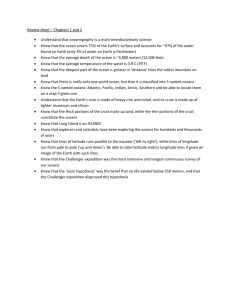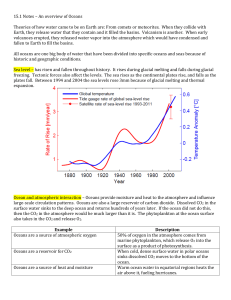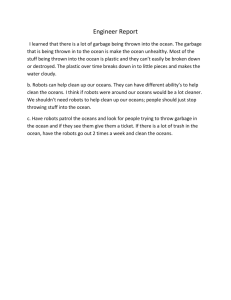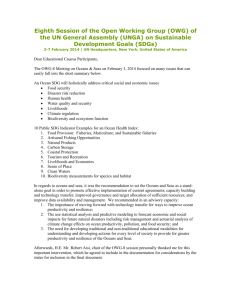Justification, Materials, Assessment, Administration
advertisement
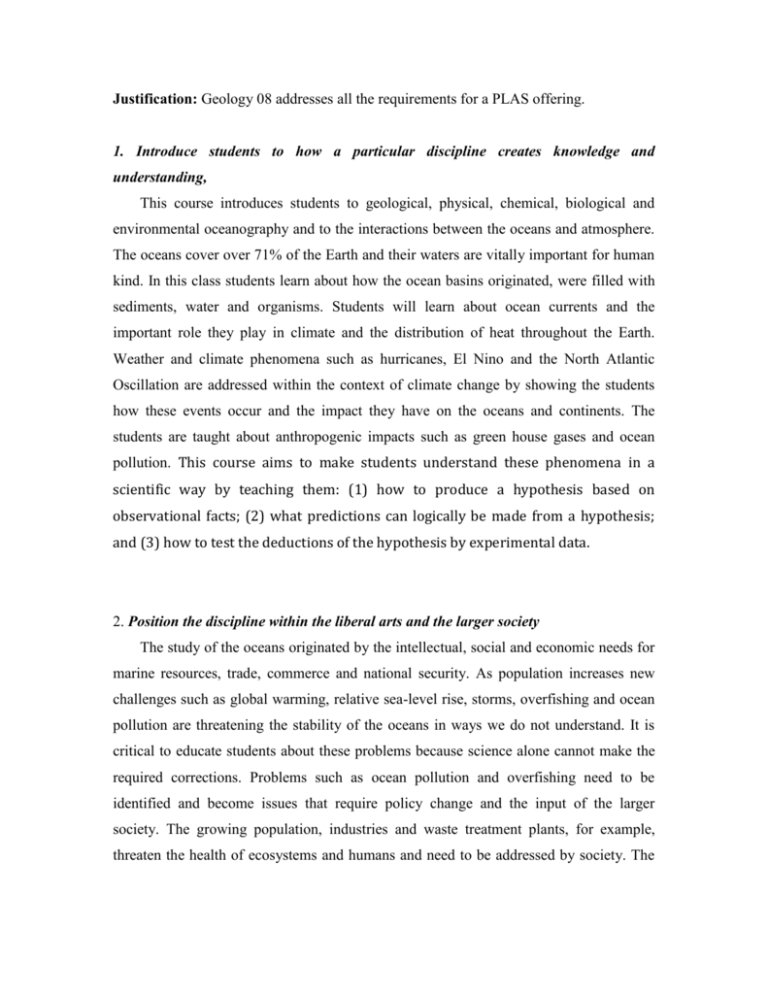
Justification: Geology 08 addresses all the requirements for a PLAS offering. 1. Introduce students to how a particular discipline creates knowledge and understanding, This course introduces students to geological, physical, chemical, biological and environmental oceanography and to the interactions between the oceans and atmosphere. The oceans cover over 71% of the Earth and their waters are vitally important for human kind. In this class students learn about how the ocean basins originated, were filled with sediments, water and organisms. Students will learn about ocean currents and the important role they play in climate and the distribution of heat throughout the Earth. Weather and climate phenomena such as hurricanes, El Nino and the North Atlantic Oscillation are addressed within the context of climate change by showing the students how these events occur and the impact they have on the oceans and continents. The students are taught about anthropogenic impacts such as green house gases and ocean pollution. This course aims to make students understand these phenomena in a scientific way by teaching them: (1) how to produce a hypothesis based on observational facts; (2) what predictions can logically be made from a hypothesis; and (3) how to test the deductions of the hypothesis by experimental data. 2. Position the discipline within the liberal arts and the larger society The study of the oceans originated by the intellectual, social and economic needs for marine resources, trade, commerce and national security. As population increases new challenges such as global warming, relative sea-level rise, storms, overfishing and ocean pollution are threatening the stability of the oceans in ways we do not understand. It is critical to educate students about these problems because science alone cannot make the required corrections. Problems such as ocean pollution and overfishing need to be identified and become issues that require policy change and the input of the larger society. The growing population, industries and waste treatment plants, for example, threaten the health of ecosystems and humans and need to be addressed by society. The more the students understand about the causes and potential solutions for these problems, the better citizens they will be. 3. Address the goals defined for the particular areas of knowledge the course is designed to fulfill. This course is designed to teach students the following areas: 1) the formation of the Earth, ocean basins, atmosphere and life 2) The ocean sediments 3) The physical and chemical properties of the ocean waters 4) Surface and deep ocean currents that mix the waters 5) The interactions between the oceans and atmosphere and climatic phenomena such as hurricanes, El Nino, and the North Atlantic Oscillation 6) Ocean waves, tides and coasts, beaches and estuaries 7) The living oceans 8) Greenhouse gases, climate change, and pollution, and natural resources of the oceans. 4. Be global or comparative in approach A course in the Earth’s oceans is global. Atmospheric and oceanic circulation patterns apply to all oceans and to the atmosphere. These processes greatly influence the climate and water balance of the continents. Relative and esutatic sea-level rise due to global warming and the melting of the ice sheets can potentially impact coastal cities, and an increased rate of storm frequency can have devastating consequences for the global economies. 6. Engage students in active inquiry The students will be introduced to scientific principles as follows: 1) a scientific hypothesis and initial explanation of the material based on physical and chemical laws; 2) hypothesis testing and formulation of a theory; 3) in today’s world anthropogenic activities are greatly modifying our environment and students will be made aware of these problems through quantitative and demonstrated facts. The student’s understanding will be enhanced through the use of the web and ocean and climate databases that will permit them to access the latest scientific findings. Exams and quizzes will provide the students with the opportunity to develop and answer essay questions such as the role of human activities in Earth’s climate change through the input of carbon dioxide, methane and other greenhouse gases to the atmosphere, and the increased pollution of the oceans by chemical and human waste. 7. Reveal the existence and importance of change over time. The evolution of the oceans and atmosphere will be studied since the initial formation of the Earth at 4.6 billion years. Ocean basins have opened and closed multiple times since then, changing the oceanic and climatic dynamics of the Earth. Students will be made aware of these long-term changes. For example, the present configuration of the ocean basins was initiated 150 million years ago and it continues to change. Students will also be made aware of climatic changes and how the Earth’s climate has oscillated from glacial to interglacial stages at frequencies of 100,000, 40,000, and 20,000 years. These climatic changes have been scientifically linked to orbital changes between the Earth, Moon, Sun and planets. Climate changes also occur at frequencies of 1000’s and 10’s of years. For example, a climatic phenomenon named “El Nino Southern Oscillation” occurs at a frequency of 5 to 7 years (although more recently 2 to 5 years). This welldocumented event has warmed the ocean waters and change climatic patters to accentuate storm frequency and droughts. El Nino has been linked to a decrease in fishing resources and crops, and has indirectly impacted the global economies. Course materials, Assignments and Activities The course text is “Introductory Oceanography” by Harold V. Thurman, 2001 Prentice Hall Inc., New Jersey. This is an excellent text for undergraduate students. The course grade is based on two intraterm and a final exam. All exams contain essay questions that are designed to make the students think about a problem. There will also be homework assignments. Student attendance and participation are key to their success and students are encouraged to be present at the lectures. Field trips to the Museum of Natural History, although not required as part of the course, have been assigned as extra credit. The students that participated in these trips thoroughly enjoyed the experience. A written assignment is required based on the trip to the museum. A syllabus of the course is attached. Assessment: Standard College evaluations are administered as supplied. In addition, the standard Department evaluation is administered once a year for a senior faculty member. The Departmental evaluations provide information about the way the students are learning the material. The students’ response and positive suggestions are incorporated in the curriculum within the framework of a PLAS class. Current instructor of this course is Dr. Cecilia McHugh a senior faculty member. Input from these evaluations has been very good and valuable in improving the course. Administration: The department approved the original course description. The department, as a committee, periodically evaluates all our courses.

